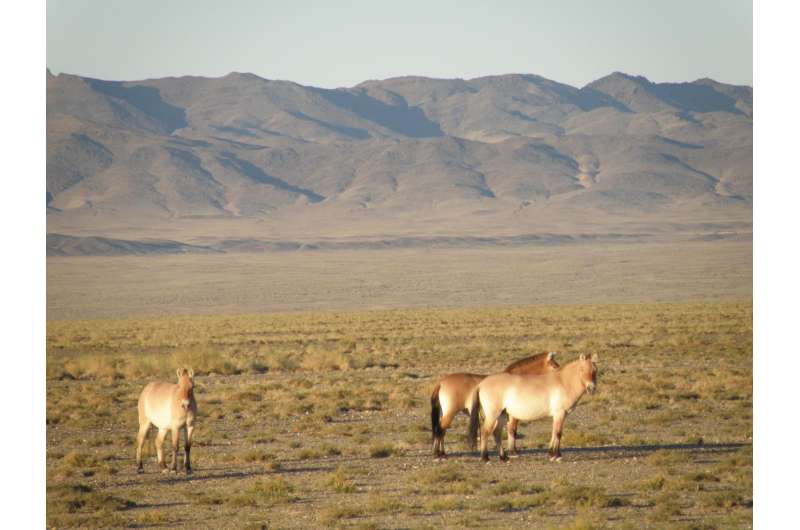Biologists learned what Przewalski's horse ate more than a century ago

A scientist from the Lomonosov Moscow State University's Faculty of Biology and colleagues have explained the changes in the diet of modern Przewalski's horses that have occurred since the end of the 19th century. The results were published in Scientific Reports.
Przewalski's horse is a species of wild horses that inhabited the Dzungarian part of the Gobi Desert until the middle of the 20th century, but were driven to extinction by humans. Several individuals survived in zoos and became the ancestors of every Przewalski's horse living today. Until the 1990s, they only were kept in zoos and breeding grounds, but with their numbers rising, ecologists decided to attempt reintroducing the species to nature. Now free Przewalski's horses roam in Mongolia and China. It is a rare example of man rectifying mistakes.
Since the end of the 20th century, several projects have attempted reintroduction (resettlement) of Przewalski's horses to nature in countries where they were historically found (Mongolia, China, Kazakhstan, and since 2015, Russia). Dzungarian Gobi was the last region where they lived, and because the wild horses there were exterminated too quickly by humans, there was no clear understanding of whether they prefer desert or steppe communities. Thus, different natural zones were chosen for the reintroduction. However, over 20 years, researchers have learned that in the Dzungarian Gobi (with desert and near-desert conditions), horse reproduction was significantly slower than in the steppe part of the country.
"The purpose of our research is to find out whether the conditions for Przewalski's horses' existence, in particular their food reserve, have changed in Dzungarian Gobi since the end of the 19th century," says Natalia Spasskaya, one of the paper's authors.
To answer this question, the researchers studied the quantity of the stable carbon isotope 13C in the tail follicles of Przewalski's horses. This isotope occurs in the tissue cells of herbaceous plants in different quantities than in the cells of woody plants; herbivorous animals accumulate this isotope by eating herbaceous sources. Thus, by its quantity, it is possible to determine whether the animal was grass-eating or leaf-eating.
Archival samples of hair from the tails of adult Przewalski's horses were analyzed. These hairs grow slowly and are not affected by seasonal molting. They were taken from the coats of the animals hunted in Dzungarian Gobi in the 19th century. Scientists compared them to the hairs of the modern Przewalski's horses reintroduced to Dzungaria. For control of the results, a similar study, also using museum specimens, was conducted on kulans, another Equidae species inhabiting Dzungarian Gobi.
In the course of their work, the researchers determined that modern reintroduced Przewalski's horses feed on herbaceous plants in all seasons, but in the 19th century, this diet only prevailed in summer. Herbaceous plants, mostly grasses, grow in the Dzungarian Gobi's plains near springs, forming oases. But some places on the plain and in the surrounding foothills are also inhabited by shrubs, which Przewalski's horses consumed during winter in the 19th century.
These seasonal characteristics of past diet are probably linked to the species expulsion from the steppe communities that are most preferable for them, and the use of the near-desert biotopes by the local people and their livestock. Living in the thicket helped the horses, among other things, to hide from the hunters. This is supported by the description of the wild horses' behavior made by the Grumm-Grzhimaylo brothers in 1890s, as well as by the memoirs of local people who still saw Przewalski's horses from the 1930s to the 1950s. Reintroduced horses are treated differently, now—they live in the protected area, where there are no people or livestock, and have become a national symbol and a tourist brand in Mongolia.
The study has also found that there were no changes in kulans' eating behavior. Their usage of fodder is seasonal, like in Przewalski's horses in the 19th century. Kulans were similarly challenged by the growing numbers of people and livestock. Earlier, they were hunted actively, but even now, though a protected species, they are illegally hunted, so kulans still avoid humans. At the same time, they are more fit for arid (desert) habitats. They have more near-desert plants in their diet, and they depend on watering less than horses. Thus, in the last century, this species has not changed its eating behavior.
"The results of the study also suggest that, in the future, the growing populations of Przewalski's horses will cause conflicts with the local cattle farmers. The future reintroduction projects—projects of resettling animals to their natural habitats—should be aimed at rehabilitating Przewalski's horses in herbaceous communities, most preferred for this species' subsistence, and must at the same time consider the higher risk of a man-induced pressure, " said Natalia Spasskaya.
More information: Petra Kaczensky et al, Stable isotopes reveal diet shift from pre-extinction to reintroduced Przewalski's horses, Scientific Reports (2017). DOI: 10.1038/s41598-017-05329-6
Journal information: Scientific Reports
Provided by Lomonosov Moscow State University



















